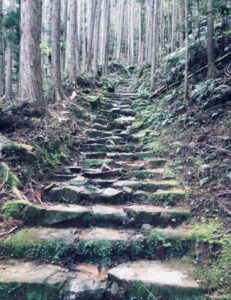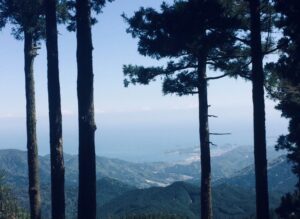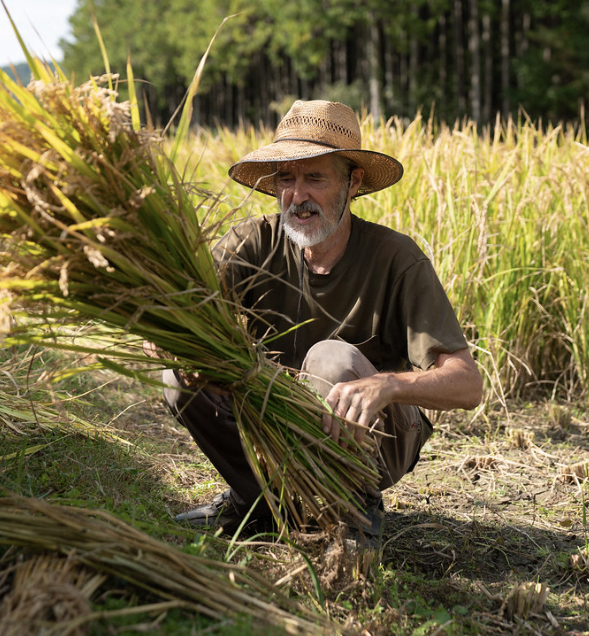
Michikusa Dreaming
by Robert Weis
[Michikusa, lit. ‘Grass on the Wayside’ is an autobiographical novel written by Soseki Natsume in 1915. The expression also means ‘wasting time along the way’.]
One week to reach Kyoto from Tokyo, in a modern-day pilgrimage, taking in Kanazawa and rambling along the centuries-old trails of the Kii Mountain range. One week amongst misty forests, wayside spirits, purification rituals, taking some distance from the world to approach the old capital “as an amazed vagabond”, echoing Tanizaki, Bouvier, Mishima and Soseki. One week of a spiritual journey that starts and ends with the element of water, tangible and intangible at the same time. Just like a dream on the wayside.
Monday, Kanazawa//Getting closer
The drops knock on the glass of the twenty-first floor: a timeless rain falls dense like a curtain, separating me from my thoughts, which are 18,000 leagues under the sea. Similar to a silent submarine, the shinkansen Tokyo-Kanazawa took me to the large provincial city also known as ‘little Kyoto’, or the Kyoto of Ura-Nihon (the backside of Japan). I plan to make my overnight stop here a rite of passage between the megalopolis and the silent paths of the Kii Peninsula that await me for the next couple of days. Twenty minutes of zazen help me to expand my mind beyond the narrow hotel room, typical of the kind of anonymous business hotel so beautifully eternalised in Sophia Coppola’s Lost in Translation. On the square in front of the train station, I take advantage of the Loop bus to reach the historical centre and Kenrokuen, reputed to be one of the three major gardens in Japan.
Bus-loads full of tourists defy the overwhelming humidity, which liquefies the last remaining cherry blossoms. I isolate myself from the crowd by contemplating the microcosm of sakura petals on the moss at the foot of the tree, nourishing the roots that generated them: a silent world of impalpable circular movement. The meaning is in the detail, the poetics of the particular revealed as in a fugue.
Tuesday Tanabe//From back to front
Physical distance prompts me to restart from zero. A long train journey along the Sea of Japan, changing trains in Osaka, finally reaching the Pacific coast. I reach Tanabe City in Wakayama Prefecture in the early evening and the first impression of the town is surprisingly pleasant. The people on the streets evocate a simplicity, openness and kindness, which strikes with the more austere atmosphere of Kanazawa, the former Samurai town. My inn is located at the edge of a nostalgic-looking neighbourhood filled with small pubs, hostess bars and family-run shops of all kinds. Things don’t appear to have changed much in the last 40 years, as is so often the case in Japanese provinces, immersing the traveller in a true vintage atmosphere. As I take a walk on the beach, the late evening sun turns the sand into gold powder, and a fresh can of beer in my hands comes with an overwhelming feeling of profound happiness. After dinner in an America-themed bar called Hangover, I keep on walking through the labyrinth of small streets. Jazz music coming from behind a curtain captures my attention: it’s a feature of Japan that usually you can’t see the inside of a bar or restaurant from outdoors, and you need a bit of an adventurous spirit to push a door to enter the unknown. I’m rewarded as the Mingus Jazz Bar reveals itself to be a hospitable place, run by the 60-year-old owner who looks like he’s 40 and drinks whisky with me and the only other client present. A provincial atmosphere, good-natured, without filters, out of time. On the way home, a woman continues screaming at a drunken businessman, under the blows of midnight. I fall asleep quickly and deeply.

Wednesday Kumano Kodo//Happiness is earned by walking
The journey begins for a second time, or rather it truly begins here, within the precincts of the Tokei-Jinja Shrine in Tanabe, established in 419 AD to guarantee a safe passage for pilgrims. The ideal temperature for a walk, a large smiling sun with a little breeze! A huge black butterfly appears, and I see it as a sign of the spiritual world, my personal kami. Indeed, the black swallowtail butterfly will be my spirit on the wayside during these days spent on the Kumano Kodo Nakahechi route.
After a short bus ride, here I am at the starting point of the trail, in the middle of the countryside! Beautiful sunshine makes the waters of the mountain torrents shine with an emerald colour. Today’s hike is only 4 km, but it’s a hard climb, from Takajiri to the small mountain village of Takahara. The scattered houses are facing the sun, just like my inn, Takahara-no-Sato Mountain Lodge. A little paradise on earth! I am greeted by wide smiles and a spectacular terrace overlooking a mountain panorama: the sunset will be wonderful seen from here.
Thursday Kumano Kodo//An island in the tree

The next day, the morning mist coats the mountains with a mysterious perfume, and a fine rain falls on the mineral and vegetal world. On my way, I find refuge in the Shinto precinct of Tsugizakura-oji, “the cherry tree embracing the cryptomeria”, yin-yang symbolism, the feminine softness of the cherry tree and the evergreen masculine strength. Is this the spiritual peak of the journey? I step into the hollow trunk of a huge Japanese cryptomeria tree, guarding the entrance to the sanctuary. A short moment of meditation, alone in the belly of the tree, surrounded by the forest in the rain and the song of small colourful birds. Inside my natural cave, the pieces of rotten wood are pointing upwards like stalagmites. The sound of the wood to the touch resounds in a hollow, earthy manner. At least four people could find refuge here. I stay for half an hour, take a few pictures, then leave. I would not want to go out anymore, but it’s necessary to advance, the road is still long, fortunately.
Afternoon, I arrive at Hosshinomon-oji, the “door of awakening”. Here, the Kumano Kodo descends from the mountains to reach the great sanctuary of Hongu. Crossing three mountain passes proved to be quite a physical exercise. A concert of toads hidden in the humid undergrowth. I spot a single sakura tree on a wooded slope in the middle of dark conifers, evoking memories of Tsugizakura, the cherry tree grafted on a cryptomeria.
Dark forest of Kumano
Only one cherry tree blossoming
Will you accept me?
In the late afternoon, after a short bus ride I finally arrive at the day’s destination, the hot springs of Kawayu Onsen. I take a hot bath next to the river in the rotenburo, the outside basin, and then immerse myself in the cold river. A true purification ritual, the sensation is strong, my head turns, I feel alive.
Friday Kumano Kodo//The light that comes from the sea

In the morning, I pay a visit to the iconic Hongu Shrine, and have an interesting meeting with an elderly Japanese man from Osaka who lives in the area and is an enthusiast of Japanese history. From our conversation, or rather his monologue, I have learnt that Shintoism represents an instrument of power for Japanese nationalists. But now it’s time to get back on track! A wonderful walk to Nachi-san under a beautiful sun and a most pleasant temperature is waiting ahead. The ascent of the Echizogoen pass takes us more than 800m higher in altitude, but without major difficulty. After four days of walking, my body has gradually become used to the effort. There’s a meditative forest. Some knots have loosened inside me, while others are in the process of being undone. The fears and preoccupations that preceded the journey proved to be unfounded. Suddenly, a view of the Pacific Ocean! Arriving in Nachi-san in the late afternoon, the sound of Japan’s tallest waterfall announces the small town, which then appears surrounded by deep forest. I spend the evening in the only hostel in the place, with groups of hikers and pilgrims, mainly Americans and Australians.
Saturday Nachi-san//The route to Kyoto

Early in the morning, I visit the impressive Nachi-san waterfall with a group of Americans whom I met the day before, before taking a long transfer by bus and train to Kyoto via Kii-Katsura.
Arriving in Kyoto, I recall the magic of my previous encounters with the city. A simple but wonderful accommodation awaits me at the Mountain Retreat with Miho and Koji, in a small wooded valley behind the scenes of the Golden Pavilion. In the evening, I meet Amy for two beers and to define our itinerary on the Kyoto Trail the next day. This will be the first evening at Takanoya pub, which will be my refuge in Kyoto. A late-night talk with Shuntaro and Sanae, two journalists from the Kyoto Shimbun: there’s something happening, a rustle in the air, tilting the distances between us. A dream or reality? Maybe this city doesn’t actually exist, as Nicolas Bouvier suspected? The contours are blurred, the unsaid is diluted in the liquid Kyoto night, as the taxi glides silently towards the mountains of the North.
Sunday Kyoto//The floating garden of dreams
Waking up next morning, I open my eyes and listen: the sound of silent rain and floating mists over the mountains behind the Golden Pavilion. The distance between dream and reality is fading away, in a new dawn.

****************
For an account of Nicolas Bouvier in Kyoto by Robert Weis, please click here.







Recent Comments